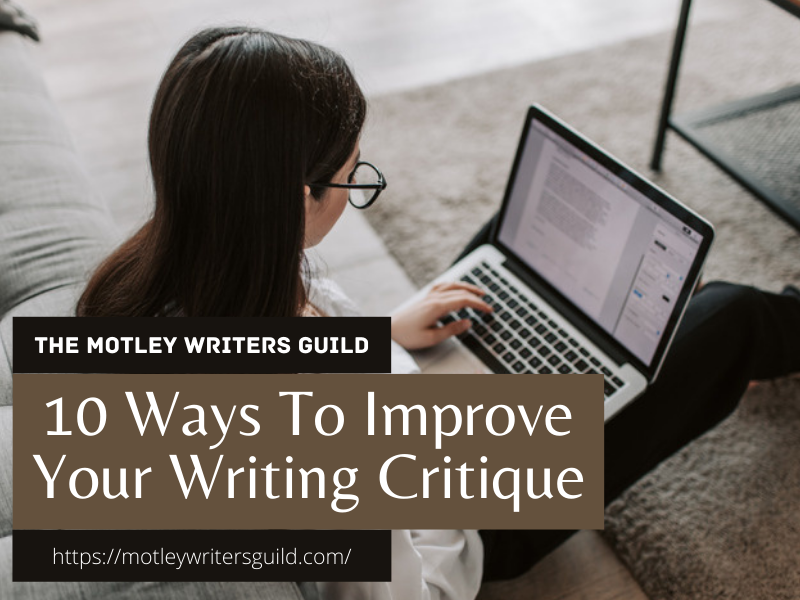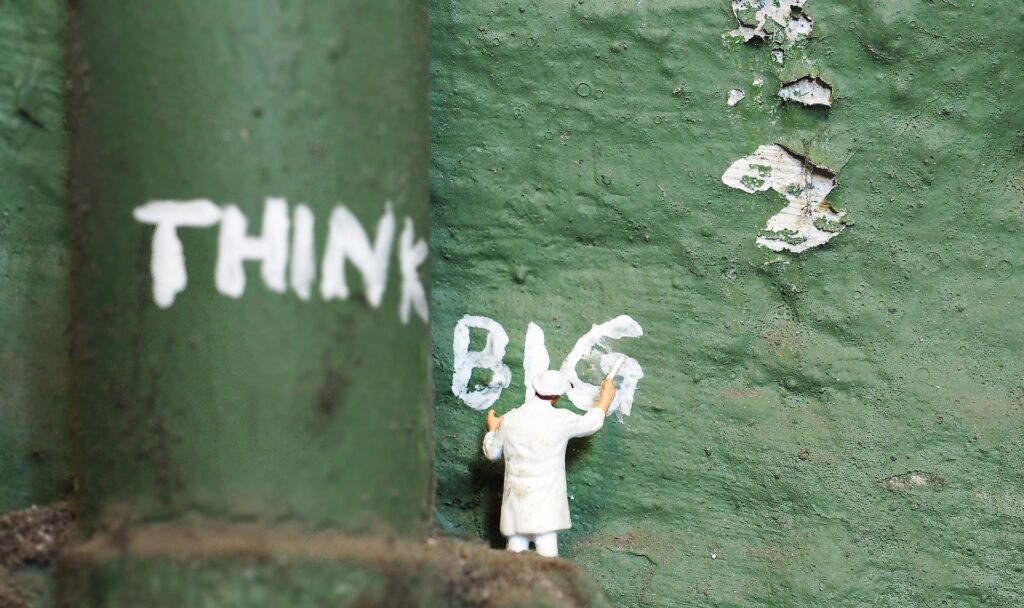
Everyone processes things differently. Each experience you have in life is unique to you and how your brain perceives it. Two people can read the same piece of text and feel differently about it and therefore give different critique.
And that’s okay!
In fact, if you’re having more than one person review your work, you probably want some variation in their responses. But this post isn’t about how to receive critique. I’ll leave that for a later date! This post is about how to give quality writing critique that will help authors understand what is and isn’t working in their writing.
Below, you’ll find some of my general tips that can help you when you’re sitting down to critique someone else’s work. I hope they’ll help you improve your feedback and avoid some common pitfalls. After all, becoming better at giving writing critique will also help you learn what feedback you want on your own work!
1 – Ask the author what kind of writing critique they’re looking for.

This is an important first step after you’ve agreed to critique someone’s work. In the same way that not everyone will give the same feedback, not everyone will want the same feedback on their writing.
If an author is giving you a second draft of their work, they may not have done any grammatical edits. More importantly, they may not be looking for that sort of feedback. You can tell them they’re missing fifty-two commas, but if they’re going to re-write major sections of the text, that information may be useless to them.
If the author wants to know how something is landing, or if a specific character is likable, you can read the work through that lens. If the author is open to receiving all critique, you can feel more comfortable commenting on whatever stands out to you.
One great trick is to ask the author to put some notes at the end of their piece with specific questions for you to consider. That way, you can read through the entire submission once with an unbiased view.
2 – Read the entire submission through once before making comments.

Obviously, this might be difficult if the work you’re critiquing is an entire manuscript. For shorter pieces, this is highly recommended. Why? Reading through something once for pleasure – with your editor brain firmly turned off and shoved into the recesses of your mind – allows you to feel the flow of the story. It can also answer questions you might have at the beginning of the submission.
This is an excellent opportunity to think about the big picture changes I’ll talk about in step #7. When you read a submission from start to finish without stopping to mull over individual sentences, it allows you to formulate your thoughts on the overall arc of the piece. Jot down some ideas after reading the entire submission and set them aside.
Once you’ve finished your first pass of the text, review the questions you requested the author leave at the bottom of their work in step #1. These will be a guide for you while you’re working through the rest of the steps.
3 – Ask yourself why you’re suggesting a change.

Most of us aren’t seasoned editors with years of experience under our belt. In fact, I’d wager that a fair few only started critiquing work in exchange for someone reading our own.
Never fear! We all start somewhere.
One of the most important things to keep in mind when giving writing critique, is why you’re getting hung up on a specific piece of text. Are you confused by the intent of the sentence? Did the author use a particular word several times in succession? Is it unclear who is saying a certain piece of dialog?
The important thing is to avoid making comments based on how YOU would have written the story. The goal of providing feedback is to help showcase the author’s vision in a clear and impactful way.
Drawing attention to what isn’t working in the text and why you feel that way will also help you in identifying why you want to make a change.
During your writing critique you are likely to come across sentences that are written in a style that is unlike your own. This does not mean they are incorrect. Identifying what is a stylist difference, what is grammatically incorrect, and what is confusing is a difficult balance that takes practice.
Consider the following passage:
“She stopped. There he was. Paul. He was standing at the end of the hallway. In HER dorm.“
The section above contains a lot of short, choppy sentences. This might not be a style you’re accustomed to reading, and potentially not one you enjoy. It might be tempting to offer suggestions to rewrite the text into longer, fuller sentences. It is beneficial to tell the author if you have read minimal work in this style, or if you find reading it makes it harder to immerse yourself. However, you probably shouldn’t start rewriting their manuscript. This may be a style they carry throughout their writing. If that is the case, you’ll need to critique around the stylist difference.
4 – Consider your wording choices.

I have yet to meet an author who doesn’t think of their work as their precious creation – their intellectual love child – their pièce de résistance. So how are they going to react if you draw a big red line across their work with the words “cut this” beside it? Probably not very well.
I’m currently enrolled in The Writer’s Studio (TWS) at Simon Fraser University in beautiful British Columbia. One trick we like to employ during writing critique is using the phrase “this bumped me.” This is a great way to tell the author that a particular passage broke you from being immersed in the reading. After all, we want readers to stay deep in our stories so they will keep reading page after page, losing all sense of time, or place, or reality….
Where was I?
Oh, right – word choices and why they’re important.
Getting across what isn’t working in a submission is very important, but there are tactful ways to go about it.
Consider this: Using our skills that we learned in step #3 – determining why we’re suggesting a change – we have concluded that a piece of dialog without a tag doesn’t have a clear speaker. What is the best way to go about communicating this?
A: Tell the author that you were unclear who the speaker was.
B: Tell the author they need to add a dialog tag.
But aren’t those the same thing you might ask? In essence, they are, yes. However, by indicating you were struggling rather than definitively telling the author what to do, you avoid making them feel defensive.
Some people might call this sugar coating, but trust me, it goes a long way to building a comfortable relationship between you and the author!
When in doubt about how to phrase something, always put the onus on yourself. ‘I was having trouble’ or ‘I couldn’t understand’. As noted earlier, our interpretation of the submission is specific to how we are perceiving it. Therefore, our reactions should be from the perspective of how WE are processing the text.
5 – Tell the author what IS working.

When you’re giving writing critique on a piece of work, it can be very easy to just focus on what ISN’T working. But no one wants to hear only things that need to be changed! We established in step #4 that authors love their work, and they want to hear that you love it too.
Feel a special connection to a certain sentence? Find yourself easily picturing the setting in a specific scene? Moved to tears or laughter by a particular passage?
Say that!
It might not seem like important feedback to leave a note saying “love this!” or “great use of descriptive text” but it can go a long way to letting an author know they’re doing something right.
Fictional stories take us on a journey. Author’s weave together an intricate tapestry of plot, setting and character all to entertain their readers. If you can tell them what emotions you felt throughout their work, they’ll know if they’re painting the picture they want.
6 – Make specific suggestions.

This might be step #6, but it’s possibly the most important thing I’ve learned in giving writing critique.
This step requires a perfect marriage between step #3 and #4 in order to pull it off with great success.
Consider which of the following comments you find most helpful in critiquing this piece of writing?:
“Johnny peered around the corner. The darkened alley was still but for a soft rustling – a mouse, perhaps? Taking a deep breath, he stepped out into the night.”
A: I could use more here.
B: I like the sensory details of the soft rustling – but I could have used a bit longer to enjoy the tension in the moment. Could Johnny have waited longer before he rounded the corner? Is he straining his eyes, looking for something? What kind of wall is he leaning against?
The more specific you are with your suggestions, the easier it is for the author to understand why something isn’t working for you.
Note in example B I used the techniques we learned in steps #4 and #5. I chose language that was not accusatory and instead displayed my interest by asking to linger longer in the scene. I also began by telling the author what I liked about the moment.
Don’t forget, we often picture a scene clearly in our mind as we’re writing it, so it’s easy to overlook areas where we aren’t putting enough of that on the page. If you can identify these moments for an author, it will help insure the image in their head is clear for their readers.
7 – Don’t forget BIG PICTURE feedback.

Go back to the notes you made after reading through the document the first time in step #2. While it is important to provide feedback at the individual line level (assuming you identified that as something the author wants in step #1), critique on the overall arc of a submission is also extremely valuable.
It’s difficult for authors to view their own work from a distance. Ever heard of the saying ‘can’t see the forest for the trees?’ This describes a situation where you’re unable to see the big picture because you’re so focused on the minor details.
Sometimes authors, in all their infinite wisdom, will unintentionally convey a message or theme that they themselves don’t realize. If you can identify the theme of their work and provide feedback on what you interpreted, it can help the author determine if they’re going in the right direction.
It helps to tell the author how quickly you read the text. This will indicate the pacing of the story. It’s good to know if a section is dragging or if the reader tore through it.
Is it a scene where someone is being chased through an abandoned hospital, afraid at any moment they’ll stumble and the monster will catch them? Chances are, the author would want the scene to be fast-paced and keep the reader in a heightened state of tension.
8 – Leave the author some questions to consider.

This isn’t vitally important, but it’s helpful. When I review someone’s work, I like to consider what questions I would have asked myself before I wrote it.
Say an author is writing a Dystopian book about a girl who lives in an isolated village in the woods. I’ll try to think of all the things I, as a reader, would want to know about her life.
Is there more to the world than her village? Does she know that?
What stops her from leaving the village?
How do they get all their food?
What about the weather? Natural disasters?
No matter how much world building an author has done in the pursuit of creating a rich and diverse world, there is bound to be something they’ve overlooked. And you can bet that if they’ve missed it, their readers will find it and let them know. Wouldn’t it be better if you could save them from that?
9 – Read your comments over again before you send them.

When I am reading over a submission for the second or third time, I will make a note of everything that comes to mind, no matter how trivial.
To spend as little time as possible not immersed in the story, I often make these notes shorthand. This can sometimes break the rule I set out in step #6 on making specific suggestions. It’s important for me to go back through my comments and ensure they’ll make sense to the author.
We’ve all been there, right? We take notes in a meeting, praising our own foresight for thinking to jot down the important things that we’d otherwise forget later. Then when we come back to those notes in a few days, it looks like some sort of coded message for which we no longer have the cipher.
Don’t let your writing critique be a coded message!
If you followed step #4, you were probably very careful with your wording choices. Reviewing your comments can still help catch any hastily noted words that might not come across the way you want them to.
10 – Thank the author for sharing their work and encourage them to ask you questions.

It’s a scary experience to share your work with someone, but ultimately important and even necessary for improving your craft. If someone has elicited your help in reviewing their work, it means they have faith in what you have to say. That responsibility carries a lot of weight.
Whenever I’m sending a piece of writing back to the author, I always take the time to thank them for the pleasure of reading their work. Not only are you gaining the experience of improving your ability to critically analyze a piece of writing, but you’re also expanding your knowledge of other works of fiction (or non-fiction, or poetry). Hopefully, you’ll also be able to count on this author to review your work in return.
It helps to build trust, and show an author you’re invested in their work, if you encourage them to ask questions about your feedback.

That’s the end of my list! Thanks for taking the time to read through my collection of 10 Ways to Improve Your Writing Critique. I hope you learned something new!
Want to find some fellow writers to collaborate with and put your newly honed writing critique skills into action? Check out Em Van Moore’s post on How To Find Your Writing Buddies!
The Motley Writers Guild’s – Julie Lynn Lorewood




Very sage advice! I think you have cracked the code on keeping the writer happy while they receive feedback and keeping them from spiraling into a pit of low self-worth!
Thanks Amber! 😊 That was definitely my goal!
You’ve really made it clear how much more there is to providing feedback than someone might at first expect, and given me a feeling that I could really up my game with your advice. There’s so much here, I feel like I should give it a reread each time I want to provide feedback in the future!